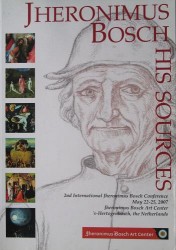
Koldeweij 2010
“… A Man like Bosch…” (Jos Koldeweij) 2010
[in: Eric De Bruyn/Jos Koldeweij (eds.), Jheronimus Bosch. His Sources. 2nd International Jheronimus Bosch Conference, May 22-25, 2007, Jheronimus Bosch Art Center, ’s-Hertogenbosch, The Netherlands. Jheronimus Bosch Art Center, ‘s-Hertogenbosch, 2010, pp. 16-29]
This is the written version of a lecture delivered by Koldeweij during the three-day conference Jheronimus Bosch. His Sources at ‘s-Hertogenbosch in May 2007. It was an evening lecture and its aim was to give the (local) general public an impression of the conference theme.
No doubt Bosch worked with a large number of visual sources: sketches, drawings, prints and probably also a large ‘curiosity collection’. Sources for research on Bosch are – apart from his paintings and drawings – archival records (in ‘s-Hertogenbosch and elsewhere), related art works, objects and texts from Bosch’s time, the religious and cultural-historical context, the reception of his works since the fifteenth century and all kinds of observations regarding his work (also the – a-historical – semiotic and psychological ones). Since the late twentieth century a number of scientific techniques have provided new sources: dendrochronology, C-14 dating, the study of pigments, x-ray photography and infrared photography. These latter techniques are able to bring to light the underdrawings of the painter’s works.
Bosch used an abundance of details to convey his Christian moralising message (basically: humankind is wicked and will have to pay the penalty for this after death). New sources regarding Bosch’s oeuvre only show up in dribs and drabs. In this context Koldeweij reports about some letters written by F.A.J. van Lanschot, an art collector from ‘s-Hertogenbosch who acquired a boschian painting in 1893, representing The liberation of the patriarchs from hell (in other words: a Christ in Limbo). Recent progress was also made in this field thanks to the Chigi-codex (containing work by Petrus Alamire), two fragments of early sixteenth-century drawings from the Arenberg-albums, a drawing that was auctioned in New York in 2003, late medieval badges and popular jewellery that could be admired at the Rotterdam Bosch exhibition in 2001 and charcoal drawings from Limburg marlpits. Further the importance of Middle Dutch language and literature for a better understanding of Bosch has recently received renewed attention.
Of course a primary source remain the works of Bosch themselves. Koldeweij announces a project supported by the Jheronimus Bosch Art Center in ‘s-Hertogenbosch whose purpose will be a close technical research of all works by Bosch and his immediate environment. Hopefully thanks to this project the paintings will betray some of their still hidden secrets, not only regarding the underdrawings but also regarding the issue of authenticity. As a first ‘test-case’ the Last Judgment triptych in Bruges has already undergone such a treatment, leading to the conclusion that we can now safely assume it stems from Bosch’s studio. The most fascinating result of the research is that the underdrawing proves that originally the left inner wing was conceived in a different way: no earthly paradise as a transitional stage on the way to heaven as we see it now, but a Fall of the Rebel Angels and a Creation and Expulsion of Adam and Eve.
[explicit 29 January 2011]